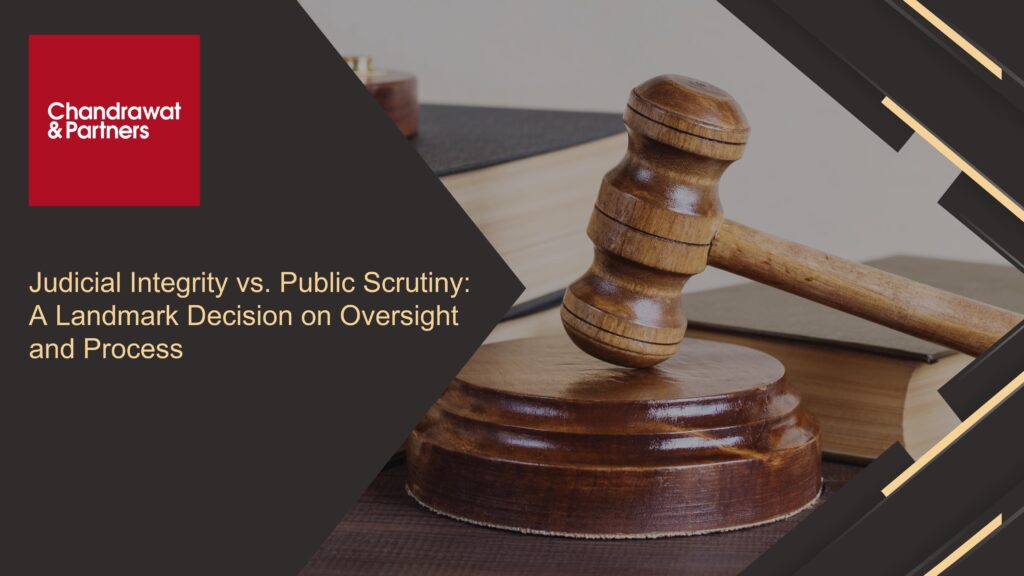Home > Recent Judgements > Judicial Integrity vs. Public Scrutiny: A Landmark Decision on Oversight and Process
May 23, 2025
Judicial Integrity vs. Public Scrutiny: A Landmark Decision on Oversight and Process
The Supreme Court of India delivered a significant judgment that touches upon the delicate balance between judicial accountability and the constitutional separation of powers. The Court dismissed a petition seeking the registration of a First Information Report (FIR) against Justice Yashwant Varma, a sitting judge, in connection with an alleged recovery of unaccounted cash from his residence.
This case sparked national interest, raising legal and constitutional questions about the accountability of judges, the jurisdiction of investigative agencies, and the role of the executive in overseeing judicial integrity.
Background of the Case
A petition had been filed before the Supreme Court, requesting directions for the registration of an FIR against Justice Yashwant Varma. The petition arose after media reports suggested that a significant sum of cash was allegedly recovered from the judge’s residence.
The petitioner argued that the alleged discovery merited criminal investigation and that judicial immunity should not obstruct a fair inquiry into potential misconduct. The case prompted widespread public debate on judicial transparency and the boundaries of institutional privilege.
Supreme Court’s Observations
In its ruling, the Supreme Court made the following key observations and clarifications:
- Internal Inquiry Already Conducted
The Court confirmed that the matter had already undergone a formal internal judicial inquiry, as per the standard protocols within the judiciary. This inquiry involved a confidential process of fact-finding and evaluation of the allegations.
The inquiry report had been finalized and submitted to the President of India and the Prime Minister.
- Role of the Executive
The Supreme Court held that any action based on the findings of the judicial inquiry is now within the exclusive domain of the executive branch specifically the President and the Prime Minister.
By referring the matter to the executive, the judiciary acknowledged the constitutional procedure laid down for dealing with misconduct by sitting judges, particularly in higher courts.
- No Grounds for Criminal Investigation at This Stage
The Court concluded that there was no prima facie material to justify the registration of an FIR. The petition lacked direct evidence, and the internal inquiry had not produced findings that warranted immediate criminal prosecution.
In line with precedents and constitutional norms, the judiciary reaffirmed that a sitting judge of the High Court or Supreme Court cannot be investigated or prosecuted without presidential sanction, as envisaged under Article 124(4) and Article 217 of the Constitution.
- Judicial Independence and Institutional Integrity
The bench underscored the importance of preserving judicial independence, cautioning against any premature or unsupported legal action that could erode public confidence in the judiciary. It stressed that due process must be followed, especially when dealing with allegations against constitutional functionaries.
Constitutional Context
The judgment is deeply rooted in the constitutional principle of separation of powers. The Indian Constitution provides checks and balances among the judiciary, the legislature, and the executive.
- Judicial Accountability Mechanisms: Allegations against judges are generally addressed through internal inquiries, followed, if necessary, by action from the President of India, based on recommendations from Parliament.
- Impeachment Process: For judges of the higher judiciary, the Constitution lays down a detailed impeachment procedure under Article 124(4) (for Supreme Court judges) and Article 217 (for High Court judges).
- Sanction Requirement: As per law and precedent, no FIR or investigation can be initiated against a sitting judge without prior sanction from the competent constitutional authority.
Public and Legal Discourse
This case stirred a national conversation about:
- The transparency of judicial proceedings
- Whether internal inquiries are sufficient in high-profile matters
- The need for reforms in judicial accountability mechanisms
- The balance between independence and oversight
While some voices called for greater openness and external oversight of judges, others emphasized the risk of politically motivated attacks on the judiciary and the importance of safeguarding institutional independence.
Implications of the Judgment
For the Judiciary:
- Reaffirms internal autonomy in dealing with allegations against judges
- Ensures that constitutional processes are followed before taking any punitive steps
For the Executive:
- Puts the responsibility on the President and Prime Minister to act on the findings of the internal judicial inquiry, if necessary
For Citizens and Petitioners:
- Highlights the limits of judicial scrutiny without substantial evidence
- Encourages reliance on constitutional mechanisms rather than public speculation or unverified media reports
Key Takeaways from the Court’s Decision
The Supreme Court’s dismissal of the FIR plea against Justice Yashwant Varma marks an important reaffirmation of the delicate balance between accountability and judicial independence. It reflects the judiciary’s commitment to due process, even while under public scrutiny.
While the internal inquiry has taken its course, it is now the executive’s constitutional responsibility to decide whether any further action is warranted. This judgment serves as a reminder of the institutional protocols that safeguard both justice and the integrity of the judiciary in a democratic society.
For more information or queries, please email us at
enquiries@chandrawatpartners.com





